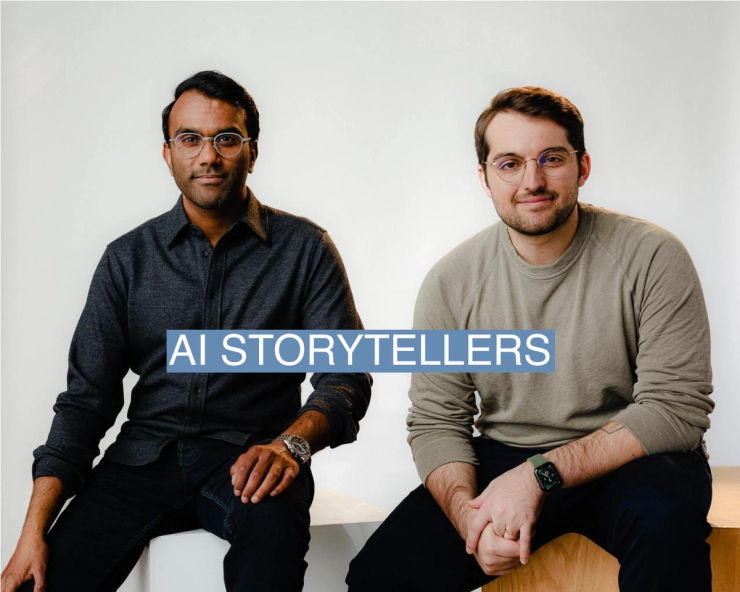The Scoop
Tome, an AI-powered tool for telling stories and sharing ideas, has reached more than 10 million users, a surprising milestone for a 10-month-old company that has taken off with Gen Z, co-founder Keith Peiris exclusively told Semafor.
It’s an example of how the wave of advancements in artificial intelligence is upending conventional wisdom in Silicon Valley. Young artists, for instance, are using the product to brainstorm ideas by repeatedly hitting the “regenerate” button, causing the AI to spit out suggestions for text and images.
Matthew Farrell, a DoorDash driver-turned-AI artist, made some Tomes — slideshows similar to PowerPoints with the design sensibility of Instagram, infused with ChatGPT, plus AI image generator Stable Diffusion — to teach people how to better use AI tools like Midjourney. Sharing Tomes on social media has helped Farrell build a following, which includes Amazon founder Jeff Bezos.
“I kind of struggle with concentration, and if I have just a bunch of random information, it can be a little overwhelming,” Farrell said. “It gives me a nice, organized storyboard that makes sense so I can take my own ideas and run with them.”
Tome was founded by Peiris and Henri Liriani, who both hail from Meta, where they worked on products like Instagram and Messenger. After making platforms used by billions of people, their slideshow startup is a bet that the way people communicate is about to change.
“At Facebook — I don’t know if it’s true anymore — they sort of had this belief that everyone should express themselves all the time,” Peiris told Semafor. “We want to help anyone tell a compelling story, [instead of saying] everyone tell a compelling story.”
The idea for Tome started out as a tool to streamline professional communication, but the company has seen it gain traction among non-business users – a development that seems to go against the Silicon Valley orthodoxy that short, fast and viral is the only path to rapid growth. Tome, for instance, is disconnected from social networking. Users can share Tomes, but must do it manually.
A subscription is $10 a month, and the company offers enterprise pricing, but most users are on the free version that has spread largely through word of mouth.
“I don’t think a good goal for this AI wave is to just get everyone to communicate everything more,” Peiris said. “That was maybe the first gen of AI companies. The power of AI is that it helps people express good things clearly.”
In this article:
Know More
The idea has buy-in from some of the biggest tech investors, from Lightspeed Venture Partners to former Google CEO Eric Schmidt to LinkedIn co-founder and Greylock partner Reid Hoffman, who have valued the company at $300 million.
Hoffman told Semafor he saw Tome becoming a valuable business tool because it would allow teams to collaborate in real-time to create slides and presentations, creating network effects that have made other companies like Slack so valuable.
But Hoffman said AI added a mass appeal that probably wasn’t there before. With generative AI, Tome gave users the ability to ask the program to automatically generate text, images, and other content based on a prompt, kickstarting the process of creating something.
Still, he said he’s been surprised to see Tome used by doctors to give their patient post-surgery instructions. And he was sent a dinner invitation created with Tome, outlining the plan for the evening.
One of the most curious twists since Tome’s launch is the following from Gen Z users, who didn’t grow up with PowerPoint presentations and traditional office tools. They make fan art for bands and recipes that they post on TikTok. “We learn more from our youngest users,” Peiris said.
“I don’t think we could have predicted how much a rocket booster AI would be for Tome,” said Dan Rose, who led Coatue Management’s investment in the company in 2021. “It’s now an AI storytelling tool.”
Los Angeles-based creative marketing agency Metahaiku has used Tome for internal communications and to attract interest for a sponsored dinner series the company is planning. “It can feel really intimidating looking at a blank screen,” said Amy Mazius, co-founder of Metahaiku. “It gets me to a great starting point where I’m already 70% of the way there and then I can just act as an editor and art director, rather than a junior copywriter.”
And Tome is a rare “business” tool that has won the approval of some of Silicon Valley’s pickiest aestheticists, like Jason Yuan, a former Apple human interface designer who decided to use it as a way to recruit talent to his startup, New.Computer. “They had default typefaces that weren’t god awful,” he said.
Reed’s view
The popularity of the app highlights what is likely the beginning of a new shift in communication that will be defined by generative AI and other forms of automation.
The internet gave us self-publishing, allowing anyone to start a blog or a newsletter with few barriers to entry. Then Web 2.0 made it even easier and faster. Speed turned into brevity. Blogs became one-sentence tweets and YouTube videos became TiKTok videos.
Generative AI may reverse that trend, shortening the time it takes to create richer and more thoughtful content.
It’s not that Tome is competing with PowerPoint. Rather, most Tomes represent content that would have been an email, a Facebook post or invite, or a Tweet storm. Much of it wouldn’t have existed at all.
It suggests that conventional predictions may have generative AI all wrong. While much of the media and lawmakers have focused on how it might enable bad actors to flood communication channels that already exist with loads of disinformation and scams, perhaps it could move us away from the kind of communication that has been so easily manipulated and destabilizing to society.
Peiris says Tome is doing to the formation of ideas what Instagram did to photos — speeding up the time from conception to creation. It’s not creating the slideshow that’s difficult. “We’re just compressing this thing that used to be very cognitively intense and laborious,” he said. “The hardest part is, ’How do I fit this idea into a narrative? What am I trying to say? How else could it say these things?”
Room for Disagreement
Critics don’t see artificial intelligence as a potential salve. Rather, it’s more of the same and policymakers should look out for the dangers.
“We missed the window on social media,” Jim Steyer, chief executive of Common Sense Media, told The Wall Street Journal. “It was late—very late—and the ground rules had already been set and industry just did whatever it wanted to do.”
“Activists and executives alike are pushing out a range of projects and proposals to shape understanding and regulation to address issues including AI’s potential for manipulation, misinformation and bias,” reported the WSJ.
Notable
- An article about Tome in TechCrunch from March 2022 is like a time capsule that shows how much the product and its meaning to consumers changed after ChatGPT burst onto the scene. It’s a great example of how AI has upended pretty much every tech startup.


